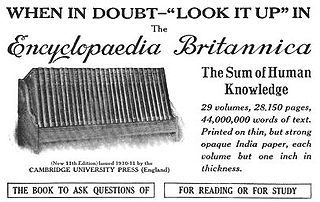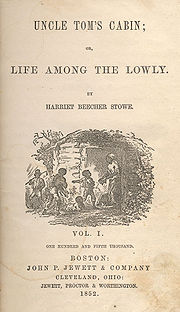
A book is a medium for recording information in the form of writing or images. Books are typically composed of many pages, bound together and protected by a cover. Modern bound books were preceded by many other written mediums, such as the codex and the scroll. The book publishing process is the series of steps involved in their creation and dissemination.

Baen Books is an American publishing house for science fiction and fantasy. In science fiction, it emphasizes space opera, hard science fiction, and military science fiction. The company was established in 1983 by science fiction publisher and editor Jim Baen. After his death in 2006, he was succeeded as publisher by long-time executive editor Toni Weisskopf.

Print on demand (POD) is a printing technology and business process in which book copies are not printed until the company receives an order, allowing prints in single or small quantities. While other industries established the build-to-order business model, POD could only develop after the beginning of digital printing because it was not economical to print single copies using traditional printing technologies such as letterpress and offset printing.

A paperback book is one with a thick paper or paperboard cover, and often held together with glue rather than stitches or staples. In contrast, hardback (hardcover) books are bound with cardboard covered with cloth, leather, paper, or plastic.

The Elements is a mathematical treatise consisting of 13 books attributed to the ancient Greek mathematician Euclid c. 300 BC. It is a collection of definitions, postulates, propositions, and mathematical proofs of the propositions. The books cover plane and solid Euclidean geometry, elementary number theory, and incommensurable lines. Elements is the oldest extant large-scale deductive treatment of mathematics. It has proven instrumental in the development of logic and modern science, and its logical rigor was not surpassed until the 19th century.
In printmaking, an edition is a number of prints struck from one plate, usually at the same time. This may be a limited edition, with a fixed number of impressions produced on the understanding that no further impressions (copies) will be produced later, or an open edition limited only by the number that can be sold or produced before the plate wears. Most modern artists produce only limited editions, normally signed by the artist in pencil, and numbered as say 67/100 to show the unique number of that impression and the total edition size.

A textbook is a book containing a comprehensive compilation of content in a branch of study with the intention of explaining it. Textbooks are produced to meet the needs of educators, usually at educational institutions. Schoolbooks are textbooks and other books used in schools. Today, many textbooks are published in both print and digital formats.
This list contains only complete, printed English-language editions of The Hobbit by J. R. R. Tolkien. It is not for derived or unprinted works such as screenplays, graphic novels, or audio books.

A hardcover, hard cover, or hardback book is one bound with rigid protective covers. It has a flexible, sewn spine which allows the book to lie flat on a surface when opened. Modern hardcovers may have the pages glued onto the spine in much the same way as paperbacks. Following the ISBN sequence numbers, books of this type may be identified by the abbreviation Hbk.
An advance reading copy, advance review copy, advance reader's edition, advance copy, or a reader's edition is a free copy of a new book given by a publisher to booksellers, librarians, journalists, celebrities, or others, or as a contest or school prize, before the book is printed for mass distribution.

An out-of-print (OOP) or out-of-commerce item or work is something that is no longer being published. The term applies to all types of printed matter, visual media, sound recordings, and video recordings. An out-of-print book is a book that is no longer being published. The term can apply to specific editions of more popular works, which may then go in and out of print repeatedly, or to the sole printed edition of a work, which is not picked up again by any future publishers for reprint.
A bestseller is a book or other media noted for its top selling status, with bestseller lists published by newspapers, magazines, and book store chains. Some lists are broken down into classifications and specialties. An author may also be referred to as a bestseller if their work often appears in a list. Well-known bestseller lists in the U.S. are published by Publishers Weekly, USA Today, The New York Times, and IndieBound. The New York Times tracks book sales from national and independent bookstores, as well as sales from major internet retailers such as Amazon.com and Barnes & Noble.

The terms special edition, limited edition, and variants such as deluxe edition, or collector's edition, are used as a marketing incentive for various kinds of products, originally published products related to the arts, such as books, prints, recorded music and films, and video games, but now including clothing, cars, fine wine, and whisky, among other products. A limited edition is restricted in the number of copies produced, although in fact the number may be very low or very high. Suzuki (2008) defines limited edition products as those “sold in a state that makes them difficult to obtain because of companies limiting their availability to a certain period, quantity, region, or channel". A special edition implies there is extra material of some kind included. The term is frequently used on DVD film releases, often when the so-called "special" edition is actually the only version released.

Tyndale House is a Christian publisher in Carol Stream, Illinois.

Inventions and Their Management is a science book by Alf K. Berle and L. Sprague de Camp. It was based on A Course on Inventing and Patenting by Howard Wilcox and Alf K. Berle, a series of nine papers presented by New York University in cooperation with Inventors Foundation, Inc., issued from 1933-1934. The Berle/de Camp version was published by the International Textbook Company in July 1937. It was reprinted, revised, in September 1940. A second edition was issued by the same publisher in April 1947 and was reprinted, revised, in January 1948, with a third printing in June 1948 and a fourth in June 1950. A third edition was issued by the same publisher in November 1951 and was reprinted, revised, in 1954. An additional printing was issued by Laurel Publishing in 1957. The work was revised and reissued under the new title Inventions, Patents, and Their Management by Van Nostrand in 1959. It was reprinted by Litton Educational publishers in 1968. The work has been translated into Japanese.

Poems is the title of three separate collections of the early poetry of W. H. Auden. Auden refused to title his early work because he wanted the reader to confront the poetry itself. Consequently, his first book was called simply Poems when it was printed by his friend and fellow poet Stephen Spender in 1928; he used the same title for the very different book published by Faber and Faber in 1930, and by Random House in 1934, which also included The Orators and The Dance of Death.

The printer's key, also known as the number line, is a line of text printed on a book's copyright page used to indicate the print run of the particular edition. The convention appears in titles published around the middle of the 20th century; it became common practice after 1970.

In printmaking, a state is a different form of a print, caused by a deliberate and permanent change to a matrix such as a copper plate or woodblock.

Poems, Chiefly in the Scottish Dialect is commonly known as the first Edinburgh Edition and the partial second setting has become known as the Stinking Edition. It is a collection of poetry and songs by Robert Burns, first "Printed for the Author" by William Smellie in Edinburgh and published or "Sold by William Creech" of Edinburgh on the 17 April, an announcement being made in the Edinburgh Advertiser on that date, although the date 21 April 1786 is given by a few authors. The Kilmarnock Edition made Robert Burns Caledonia's Bard whilst the 'Edinburgh Edition' elevated him into a position amongst the world's greatest poets.

















